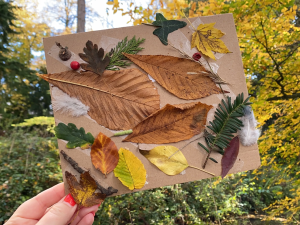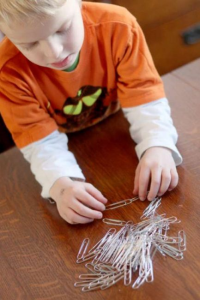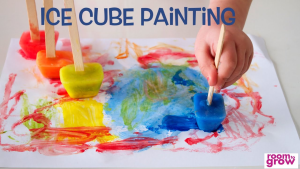Engaging children in creative activities is not only entertaining but also essential for their overall development.
Transient art, a form of artistic expression using temporary materials, offers a unique and exciting way for kids to explore their creativity.
From natural objects like leaves and flowers to everyday items like buttons and paper clips, transient art encourages children to experiment, manipulate, and arrange materials to create visually captivating compositions.
Now, we present fun & easy transient art activities for kids that will inspire their imagination, foster their fine motor skills, and ignite their passion for artistic expression.
Let’s dive in and discover the wonders of transient art together!
Nature Collage:

Take the little artists outdoors to collect an assortment of natural materials such as leaves, flowers, twigs, and pebbles. Provide them with a large piece of paper or cardboard as their canvas. Encourage them to arrange the collected items in various patterns, shapes, and designs to create a captivating nature collage. The ephemeral nature of these materials adds an element of excitement as they piece together their artwork, and children can learn about different textures, colors, and shapes found in nature while engaging in this creative activity.
Paper Clip Chains:

Give children a pile of colorful paper clips and challenge them to create long chains by linking the clips together. They can experiment with different color patterns or create chains of varying lengths. This activity not only encourages their fine motor skills but also sparks their creativity as they explore different ways to connect the clips. The transient nature of the chains allows children to dismantle and recreate them, providing endless opportunities for artistic exploration.
Related: 20 Fun Zoom Games for Large Groups
Ice Painting:

Prepare colorful ice cubes by adding food coloring to the water and freezing them. Provide children with a large sheet of paper or a canvas and let them use the melting ice cubes to paint. As the ice melts, the colors blend and create unique patterns and designs. Children can experiment with different techniques, such as rubbing the ice on the paper or dripping melted water from the ice cubes. This activity not only sparks creativity but also introduces children to the concept of using alternative materials for painting.
Button Mosaics:
Gather a collection of colorful buttons in different shapes and sizes. Provide the kids with a flat surface such as a foam board or a piece of cardboard and some glue. Let their imagination run wild as they arrange and glue the buttons onto the surface, creating beautiful and intricate button mosaics. This activity not only allows children to explore color combinations and patterns but also enhances their fine motor skills as they handle and manipulate the buttons.
Source: minikar.ru
Sand Art:
Fill shallow trays or containers with colored sand in various shades. Children can use their fingers or small tools like spoons or brushes to create mesmerizing designs and patterns in the sand. They can experiment with layering different colors, making swirls, or even creating landscapes. The temporary nature of sand art adds an element of surprise and allows children to explore their creativity without the pressure of making permanent artwork. Plus, they can easily reshape the sand and start afresh whenever they want.
Source: howwemontessori.com
Recycled Sculptures:
Encourage eco-conscious creativity by providing children with a variety of recyclable materials such as cardboard tubes, plastic bottles, yogurt containers, and bottle caps. Let their imaginations soar as they transform these discarded items into unique sculptures. They can use glue, tape, or even twist and fold the materials to create interesting shapes and structures. Not only does this activity promote creativity, but it also teaches children about the importance of recycling and repurposing materials.
Source: naturalbeachliving.com
Leaf Stamping:
Venture outside with the children to collect a variety of leaves in different shapes and sizes. Once back indoors, provide them with paint and large sheets of paper. Instruct the children to dip the leaves into the paint and press them onto the paper, creating beautiful leaf prints. They can experiment with different colors and arrange the prints in unique patterns to make their artwork truly one-of-a-kind. This activity not only allows children to explore nature’s textures and patterns but also encourages them to discover the artistic potential of everyday objects.
Source: craftsbycourtney.com
Tissue Paper Collage:
Cut or tear colorful tissue paper into various shapes and sizes. Provide the children with a sheet of contact paper and let them arrange the tissue paper pieces onto it, creating a vibrant collage. Once they are satisfied with their design, cover the collage with another sheet of contact paper to seal the tissue paper pieces in place. The translucent nature of tissue paper adds a beautiful effect to the artwork, and children can experiment with layering different colors to create depth and visual interest.
Source: scholastic.com
Chalk Art:
Take the transient art outdoors by using chalk on sidewalks or pavement. Give children a wide range of colorful chalk and let their creativity flow as they create temporary masterpieces on the ground. They can draw imaginative scenes, and colorful patterns, or even play interactive games like hopscotch. This activity allows children to explore large-scale artwork while enjoying the tactile experience of drawing with chalk.
Source: newfolks.com
Found Object Sculptures:
Encourage children to collect various small objects or materials from around the house or outdoors, such as bottle caps, feathers, ribbons, or seashells. Provide them with a base material like clay or playdough and let their imagination guide them as they create unique sculptures using the found objects. They can experiment with different arrangements and combinations, attaching the objects to the base material to bring their sculptures to life. This activity not only promotes creativity but also enhances children’s observation skills as they discover the artistic potential in everyday items.
Source: momjunction.com
Food Art:
Explore transient art using edible materials. Provide children with a selection of fruits, vegetables, and other food items with interesting textures and colors, such as sliced cucumbers, oranges, or berries. Encourage them to arrange the food items on a plate or a large surface to create visually appealing and temporary food art. They can experiment with different arrangements, making patterns or even forming recognizable shapes. This activity not only stimulates creativity but also encourages children to appreciate the artistic possibilities in everyday objects, including food.
Source: nurseryworld.co.uk
Shadow Play:
Utilize sunlight or a strong light source to create a transient art experience. Encourage children to arrange objects such as toys, leaves, or cut-out shapes on a surface, like a piece of paper or a wall. As the light casts shadows, children can explore the interplay between light and objects, creating intriguing and ever-changing compositions. They can experiment with different angles and positions to manipulate the shadows and create captivating temporary art pieces.
Source: happinessishereblog.com
Yarn Wrapping:
Offer children a variety of colorful yarns and threads. Provide them with objects like cardboard shapes, sticks, or empty paper rolls. Instruct them to wrap the yarn around these objects, creating intricate designs and patterns. They can experiment with different color combinations and textures, exploring the possibilities of yarn as a versatile artistic material. This activity enhances fine motor skills and encourages children to think three-dimensionally as they wrap and layer the yarn.
Source: laughingkidslearn.com
Bubble Wrap Printing:
Cut small pieces of bubble wrap and attach them to a firm surface, such as a piece of cardboard. Offer children a selection of paint colors and brushes. Encourage them to apply paint onto the bubble wrap and then press it onto a sheet of paper, creating unique prints with characteristic bubble patterns. They can experiment with different pressures, colors, and arrangements to produce intriguing and textured transient artworks.
Source: firstpalette.com
Recycled Collage:
Collect a variety of recycled materials, such as newspaper clippings, magazine cut-outs, fabric scraps, and cardboard pieces. Provide children with a large sheet of paper or a canvas and let them arrange and glue the recycled materials onto it, creating a collage that tells a story or conveys a theme. This activity not only promotes creativity but also encourages environmental awareness and resourcefulness as children repurpose discarded materials to create their artwork.
Source: feltmagnet.com
Salt and Watercolor:
Provide children with watercolor paints, brushes, and a sheet of watercolor paper. Instruct them to create colorful designs or illustrations on paper using watercolors. While the paint is still wet, sprinkle salt over the painted areas. As the salt absorbs the water, it creates unique textures and patterns. Children can observe the fascinating effects of salt on their artwork as it dries, resulting in beautiful and transient masterpieces.
Source: hgtv.com
Shaving Cream Marbling:
Spread a layer of shaving cream onto a flat surface, such as a tray or a table. Drip a few drops of liquid watercolors or food coloring onto the shaving cream. Encourage children to use a toothpick or a skewer to swirl and mix the colors into the shaving cream, creating marbled patterns. Once the patterns are to their liking, place a piece of paper on top of the shaving cream and press down gently. Peel off the paper and scrape away the excess shaving cream to reveal a stunning marbled print. The transient nature of the shaving cream art adds an element of surprise and excitement to the process.
Source: kiwifamilies.co.nz
Nature Weaving:
Take children on a nature walk to collect natural materials with flexible or pliable properties, such as long grass, thin branches, or vines. Provide them with a circular or rectangular frame made of cardboard or a found object like a hoop. Instruct them to weave the collected materials through the frame, creating intricate patterns and designs. They can experiment with different weaving techniques, colors, and textures, resulting in beautiful and temporary nature-inspired artworks.
Source: communityplaythings.co.uk
Sticker Art Collage:
Offer children a variety of stickers in different shapes, sizes, and designs. Provide them with a large sheet of paper or a canvas and let them arrange and stick the stickers onto it, creating a vibrant and whimsical collage. They can mix and match stickers, layer them, or even overlap different shapes to create visually interesting compositions. This activity allows children to explore their creativity while developing their fine motor skills and spatial awareness.
Source: schooltimesnippets.com
Bubble Art:
Mix liquid dish soap with water and pour the solution into shallow containers. Add a few drops of liquid watercolors or food coloring to create colorful bubble mixtures. Provide children with straws and instruct them to blow gently into the mixture to create bubbles. Once the bubbles rise above the container’s edge, encourage them to place a sheet of paper on top of the bubbles, allowing them to burst and leave behind vibrant and transient bubble prints. Children can experiment with different colors and blowing techniques to create unique bubble art.
Source: kidsactivitiesblog.com


